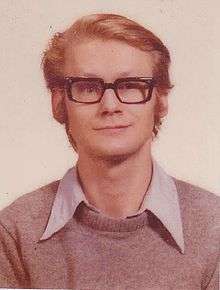Leif Erland Andersson
| Leif Erland Andersson | |
|---|---|
 | |
| Born |
4 November 1943 Falkenberg, Halland County, Sweden |
| Died |
4 May 1979 (aged 35) Falkenberg, Halland County, Sweden |
| Cause of death | Lymphoma |
| Nationality | Swedish |
| Education | Ph.D. |
| Alma mater | Lund University, Indiana University Bloomington |
| Occupation | Astronomer |
| Spouse(s) | Gloria Ptacek |
Leif Erland Andersson (4 November 1943 – 4 May 1979) was a Swedish astronomer.[1]
Andersson had been a child prodigy who won the Swedish television quiz show 10.000-kronorsfrågan ("The 10,000 Kronor Question") twice, the first time at age 16.[2]
From his late teen years, he was also a well-known science fiction fan in Sweden, who chaired the MalCon in 1966 in Malmö[3] and took over editing the pioneering Swedish science fiction amateur journal, the Scandinavian Amateur Press Alliance (SAPA) after John-Henry Holmberg left the position some time after 1964.[4]
Andersson studied astronomy at Lund University,[5] but received a scholarship to San Michele Observatory in on the island of Anacapri in Sicily in 1968.[6]
He studied the work of Professor Åke Wallenquist,[7] at Uppsala University. Andersson later went to Indiana University Bloomington to complete his Ph.D. degree. While there, he married Gloria Ptacek in 1973 at the Beck Chapel of Indiana University.
Andersson was hired in a post-doctoral research associate position in the summer of 1973 by Dr. Gerard Kuiper[8] at the Lunar & Planetary Laboratory[9] of the University of Arizona in Tucson, Arizona. Andersson calculated the first observable transits of Pluto and Charon[10] in the early 1980s, but did not live to see them.[11]
He mapped the far side of the moon in NASA's Catalogue of Lunar Nomenclature, with co-author Ewen Whitaker, published in 1982.[12]
After his death from lymphatic cancer at the age of 35 in 1979, the crater Andersson on the Moon was named after him.[13] He was survived by his wife.
In honor of Leif Andersson's work on the determination of Pluto's pole position, the Spacewatch Asteroid Project at the University of Arizona's Lunar and Planetary Laboratory named an asteroid in his honor in the Minor Planet Circular of 18 December 1995, p. 827:[14]
References
- ↑ "Svenskar på månens yta" (in Swedish). Retrieved 20 June 2015.
- ↑ Gradvall, Jan (2009). Tusen svenska klassiker: böcker, filmer, skivor, tv-program från 1956 till i dag. (in Swedish). Stockholm: Norstedt. ISBN 978-91-1-301717-4.
- ↑ Roimola, Ben. "Sven Christer Swahn är död". Enhörningen (Unicorn). Enhörningen Magazine. Retrieved 23 September 2014.
- ↑ Lynch, Richard. "Chapter 5: Notable Fanzines of the 1960s". Fan History Book of the 1960s. The Joe Phan Organization. Retrieved 25 September 2014.
- ↑ "Lund University Astrophysics program". Lund University. Retrieved 22 September 2014.
- ↑ "Experiences from 16 Years of Solar Work in Anacapri". SAO/NASA Astrophysics Data System (ADS) Web Site. The SAO/NASA Astrophysics Data System. Retrieved 23 September 2014.
- ↑ "Åke Wallenquist (1904-1994)". Department of Physics and Astronomy, Uppsala University. Uppsala University. Retrieved 23 September 2014.
- ↑ "Gerard P. Kuiper Biography". Gerard P. Kuiper Papers. University of Arizona Libraries Special Collections. Retrieved 22 September 2014.
- ↑ "Lunar and Planetary Laboratory home page". Lunar and Planetary Laboratory, Univ. of Arizona. Retrieved 22 September 2014.
- ↑ "Charon Overview". NASA Solar System Exploration: Charon Overview site. NASA. Retrieved 22 September 2014.
- ↑ Jones, Barry W. "Pluto: Sentinel of the Outer Solar System". Cambridge UP Catalogue. Cambridge University Press. Retrieved 22 September 2014.
- ↑ Andersson, Leif; Whitaker, Ewen. "NASA catalogue of lunar nomenclature". NASA Technical Reports Server. NASA. Retrieved 23 September 2014.
- ↑ "Andersson Moon Crater: Gazetteer of Planetary Nomenclature". International Astronomical Union (IAU) Working Group for Planetary System Nomenclature (WGPSN). Retrieved 21 September 2014.
- ↑ International Astronomical Union. "Minor Planet Center Circular" (PDF). IAU. Retrieved 22 September 2014.